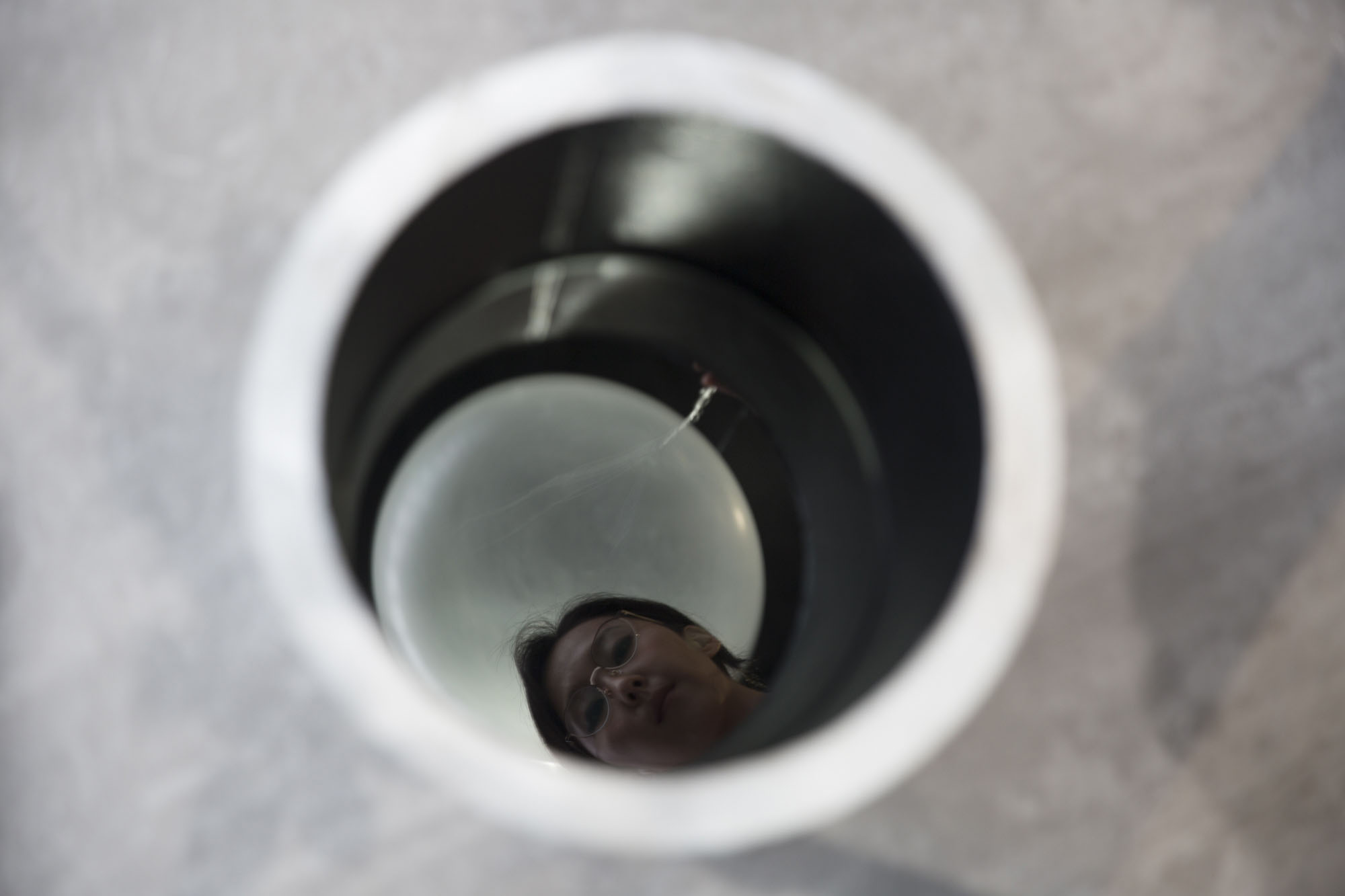에라,
Juxtaposed_pretty-fun-comfy (•_•)
2019
1. Helium gas, black mirror, transparent urethane-string-net, Wubble Bubble, bucket
2.Glass, metal, walnut wood, polymer clay, epoxy putty, plastic powder, purified water, glycerin, motors, gears, bearings, chains
3. hand-made bean bag chair : fabric, zipper, EPS(expanded polystyrene foam 260L)
4. Slim:e borax, detergent, glitter powder, beads, plastic pearls 5. Polymer clay, ink, pigment, latex, baby powder, expansion foam, styrofoam etc.
Photography: Seungwon Yang, provided by Nam June Paik Art Center



Juxtaposed_pretty-fun-comfy (o_o)
Artist's Note
I present in the exhibition space a series of "comfy," "fun," and "pretty" objects that are not environment-friendly and even environmentally damaging to some extent. Although the nature of this work is not didactic in a straightforward manner, they nonetheless are meant to compel the viewer to look into the materials used for each work--either during or after the show--and seek out the implications that such materials have in a different and broader context. What follows is a list of work descriptions.
A Bucket Reflecting a Helium-filled Balloon and the Onlooker: The Desire for a Better Life
Around early 2019, a number of articles reported on the surge in the prices of helium, which aroused concerns from not only the manufacturing industry but also the meteorological and medical field. Although most of us associate helium with balloons, the common use of helium isn't limited to that of entertainment. In fact, they are critical for making our life "better" or more "convenient." Although helium is the second most abundant element in the universe next to hydrogen, it is difficult to obtain them from the atmosphere in its gas state due to its lightness that defies the gravity of Earth. Therefore, helium is more commonly extracted from radioactive minerals or as byproducts of natural gas. South Korea imports all of its helium, more than 70 percent of which is used in the semiconductor and display industry. Other applications of helium range from MRI and barcode scanning to air balloons for meteorological and military use.
With such implications of helium in mind, I float a helium-filled ball in the exhibition space, underneath which a bucket with black reflective bottom is placed, whereby the viewer catches a reflection of her face as well as the helium ball when looking into the bucket.
The "Pretty": Mimicking Nature in Enclosure
Snow globe refers to a sphere made of glass filled with liquid and white plastic particles that are meant to resemble snow, often adorned with miniature sculptures that constitute a landscape or a particular scenery.
The exhibition room on the second floor of Nam June Paik Art Center has one side of its walls covered entirely in glass, over which lies urban green space. While this seems like a snow globe turned inside out--albeit in different seasons--both structures remind us of how the notion of "nature" itself may seem anthropocentric.
This section of the exhibition presents a snow globe that is no longer a miniature. The tree and the snowman inside it are made of polymer clay and epoxy putty, with plastic flakes and glitter mimicking snowstorm. The storm effect is generated by a machine that keeps the snow globe turning, next to which a bean bag chair is placed. The viewer is invited to sit and enjoy not just the sight of the snow globe but also the urban green space over the glass wall.
"Fun" Slime and "Comfy" Bean Bag Chair
Usually, fillers for bean bags are made of expanded polystyrene (EPS), a type of plastic produced through a foaming process by which polystyrene beads, commonly known as styrofoam, are permeated with a blowing agent and expanded. EPS has been held responsible for environmental pollution, as most EPS products have not been recycled due to the lack of monetary incentive.
As for PVA, a water-soluble polymer used for making Slime, it is slow to biodegrade, which raises the risk of water pollution. Furthermore, Slime often comes with various other materials such as glitter, beads, fake pearls, and other small toys, all of which are made of plastic. Although the product has enjoyed world-wide popularity for quite some time, discussions on how to dispose of them in an eco-friendly way have only begun recently.
As for PVA, a water-soluble polymer used for making Slime, it is slow to biodegrade, which raises the risk of water pollution. Furthermore, Slime often comes with various other materials such as glitter, beads, fake pearls, and other small toys, all of which are made of plastic. Although the product has enjoyed world-wide popularity for quite some time, discussions on how to dispose of them in an eco-friendly way have only begun recently.
On Making Three-dimensional Work
This sculpture alludes to environmental consequences of making three-dimensional work. The spherical objects stand in for an ideal that cannot materialize in the physical world, i.e. a perfect sphere. Accompanying them are trails of their skins (or cuticles), which can be read as byproducts of the process of striving toward perfection, or, making "better" work.
The sphere in the center is surrounded by conic shapes with black glass mirrors placed in front and back, arranged in a way meant to resemble a light cone--a path of light in spacetime. The black glass mirrors allow the viewers to see the work on two-dimensional level, which sheds a new light on the aforementioned concepts such as perfect sphere, shedding (or ecdysis), etc.
Yoon, Jiyoung “Juxtaposed_pretty-fun-comfy (o_o)” In Ecological Sense. Jeongwha Goo ed. South Korea: Nam June Paik Art Center. 2019.
ISBN 978-89-97128-52-5[93600]